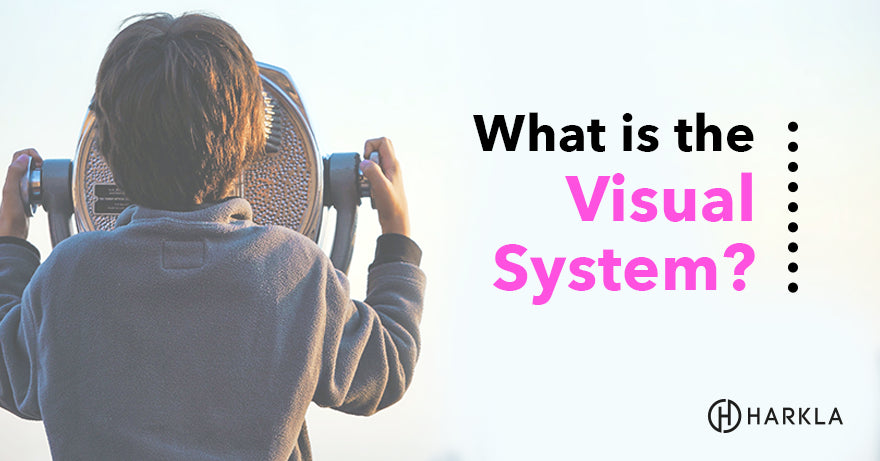Your Cart is Empty

Our visual system allows us to not only see what is in our environment but also allows us to process, interpret, and understand what it all means. It’s not just about how clearly we can see - that’s visual acuity - but it’s also about how our brain understands what we see, as well as our ability to formulate a response to what we see.
The visual system is developed in the womb. However, it is the least mature system at birth (relative to the other sensory systems). By approximately two months of age, an infant can begin associating meaning to what they see. By three months of age, an infant can begin visually tracking objects within their environment and may even grasp items and bring those items into their visual field. The infant begins recognizing faces between ages 4-6 months and reaching and grasping for preferred items. By 12 months, the infant has started to understand object permanence - knowing that an object still exists even when it’s not visible.

The visual system has a significant impact on social development as well. Think about eye contact and watching, processing, and understanding body language. Additionally, the visual system plays a very important role in learning and education. Everything from walking and running, riding a bicycle, and climbing to reading and writing requires effective visual processing.
Additionally, our visual sense is directly related to our vestibular sense (our sense of motion). When we are in motion, our sense of vision helps us direct and understand that motion or movement. Because our vestibular system is located in our inner ears and is activated by head movement and head position changes, it’s easy to see how our vision is directly linked - when our head moves, our eyes move. Try this: close your eyes and take five steps forward. How did that feel? Probably a bit tricky and maybe even a bit scary. That’s because, without the use of our visual system, our vestibular system and the sense of where our body is in space gets thrown off.
Let’s look at some of the different types of visual processing - what they are, what they help us with in daily life, what it looks like if a child struggles with that particular area, and some tips and tricks to help!
Visual discrimination can be defined as “the ability to detect differences in and ability to classify objects, symbols, or shapes. These can be categorized by color, position, form, pattern, texture, as well as size.” This visual processing area is particularly important for children learning to read and write - they need to be able to discriminate between different letters and numbers. Visual discrimination helps to identify similarities and differences in various objects.
What are some signs that a child might be struggling with visual discrimination?
If your child struggles with visual discrimination, try some of these activities to help boost this skill:
Visual figure ground is the ability to identify and pick out a specific object within a busy environment. This skill is essential for navigating the environment, reading and writing, and other cognitive tasks. Additionally, this can impact household tasks such as locating a specific item to cook within the kitchen or choosing a weather-appropriate clothing item from the closet.
What are some signs that a child might be struggling with visual figure ground?
If your child struggles with visual figure ground, try some of these activities to help boost this skill:
Visual sequencing is the ability to organize items in a specific order. This area of visual processing is important for reading and writing, math skills, sports that require specific sequencing of events (such as running bases in baseball, coordinating plays in football, or sequencing cheers in cheerleading), and self-care tasks such as cooking or getting dressed. Visual sequencing is directly related to coordinating the body, planning, and executing a task.
What are some signs that a child might be struggling with visual sequencing?
If your child struggles with visual sequencing, try some of these activities to help boost this skill:

Visual memory is the ability to recall something that was previously seen; to recall visual information on-demand. This particular skill is necessary for reading and writing. Additionally, visual memory assists with navigating our environment - not just our home, but also out in the community. Visual memory also helps us recall details about people we meet, places we’ve been, and information we’ve read or seen (such as a detail from a book or a scene from a movie). Visual memory also plays into our emotions, as seeing something from our past can trigger a memory and an emotion.
What are some signs that a child might be struggling with visual memory?
If your child struggles with visual memory, try some of these activities to help boost this skill:
Visual closure is the ability to see part of an object and know what that object is. This requires visualizing the whole when only seeing a part. This skill is necessary for higher-level reading skills, locating objects within busy environments, and potentially predicting outcomes.
What are some signs that a child might be struggling with visual closure?
If your child struggles with visual closure, try some of these activities to help boost this skill:
Visual-spatial processing is the ability to understand where objects are in space. This includes location, depth, and how those objects relate to each other as well as to you. This skill is essential for safely navigating our environment, from walking to playing sports to driving. This skill is also necessary for reading and writing, tying shoes, and motor planning.
What are some signs that a child might be struggling with visual-spatial processing?
If your child struggles with visual-spatial processing, try some of these activities to help boost this skill:
Visual motor is the combination of several visual perceptual skills as well as motor skills. Often referred to as hand-eye coordination, visual motor integration includes seeing something and coordinating a motor action to complete a task (as well as visually understanding what is happening!). This skill is essential for handwriting tasks, sports, and other ball-skill tasks, play activities such as climbing and riding a bicycle and even navigating through the environment.
What are some signs that a child might be struggling with visual motor integration?
If your child struggles with visual motor integration, try some of these activities to help boost this skill:

As discussed at the beginning of this article, our visual and vestibular systems are connected. When our head moves, it activates the vestibular system and simultaneously moves our eyes at the same time. This integration is required for safely navigating our environment, riding a bicycle or a skateboard, playing sports, and is directly related to visual motor integration.
What are some signs that a child might be struggling with visual-vestibular integration?
If your child struggles with visual vestibular integration, try some of these activities to help boost this skill:

Vision therapy is a subspecialty of developmental optometry that focuses on visual processing and perceptual skills.
The focus is not on visual acuity, but many of the things this article discussed, including specific visual motor skills such as visual tracking and saccadic eye movements.
If your child experiences any challenges as mentioned in this article, seeking out a vision therapy center may be beneficial.
While there are a LOT of details that go into visual processing, they are all connected! By completing more activities that require the use of different visual processing skills, you can help your child improve many skills.
To learn more about other sensory systems, check out our full article on sensory processing disorder.
This, platform teaches alot, any short tutorial please
Comments will be approved before showing up.


Mathy
January 23, 2024
Do you treat visual in integration problems with torticolis children?